As you know The RCC Slab Casting checklist is an important steps while building a House. according to the building code of design, There are few design steps to keep in mind when starting the superstructure of House. As a house owner maybe you don’t know anything about these codes. So, this Informative blog is for you to know simple but most important things while Your house is going casting the Slab (Chatt ki Dhalai in India).
What are the things to be kept in mind while casting the roof?
Onsite RCC Slab Casting Checklist should be ready Before casting the roof is one of the Important steps for Proper care of your House, We’ll Discuss below in Following sequences-

If you are planning to cast the Roof, these are the important points to note down-
1. Sufficient materials RCC Slab Casting
It’s a main concern that material should be sufficiently available while roof casting. All the quantities are known through the contractors because they know well about how much materials will be required for that much square foot of roof casting.
For an example, if you are constructing a 1250 square feet house, then the contractor will tell you the approximate quantity of the materials as such quantity .(84 bag cement, 3 trolli aggregate, 2 troll Sand)
There should not be a shortage in the middle of the work. Following materials you’ll need to collect before the casting process-
a). Cement
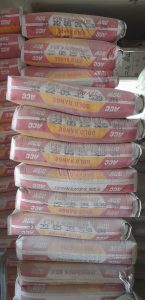
These are the round Figures of the Numbers of Cement bags required for the specific dimension of house roof.
The Contractor can Guess the Numbers of Cement as for 50 sq ft roof casting (4.5 inch Thickness roof) almost 40-45 Bags of cement are needed.
And cement bags required for a 4000 sq ft RCC roof slab is 280 Bags.
For the Roof Casting in India, ACC f2R or ACC Gold is Best.
To know the Details for the Best cement in India–Click HERE To Read The Informative Blog.
b). Sand
Use river sand for the casting work. ask the contractors how much Tractor/Hiva Sand will be sufficient for casting the whole slab.
Example- For Covering the 4000 Square feet Along with the beam, there will need 13 Tractors (100 CFT per tractor sand) for the Entire Slab Casting.
c). Aggregate
Maximum 40 mm Size is good for the roof casting. you can prefer the crusher aggregate for the slab casting. To complete the 4,000 Square Feet along with the Beam need 15 Tractors (100 ft Per tractor) will need to complete the roof.
d). Binding Material
Latex Should be poured in each column that acts like the bonding agent with the concrete before pouring the freshly mix concrete over the centering.
make sure to purchase the Latex box before the casting of slab.
e). Waterproof Liquid
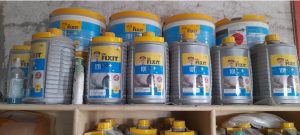
It is necessary to put waterproof liquid at the time of floor casting. Also, use anti-termite Chemicals to protect the floor slab.
Use UltraTech Weather “Pro Dr. fixit ILW+” for the waterproofing of the slab. You can also prefer “Dixit LW 101″
See the written description in the Dr. Fixit Bottle such as (10 Liter Bottel will require 25 Bags of Cement)
Construction of a 4, 000 square feet roof needs 300 Bags (Each 50 Kg) which requires 12 Bottle (Each 10 L Bottle)
2. Mixture Machine/Equipment Or Machinery
Make sure to Arrange the machinery from the local builders who provide rent for a Day. tell them to fit all the equipment a day before the slab casting. Because if they will fit on the same day, it may have risks, and doing the casting work takes time even up to the night.
Casting work must start from 9- 9:30 A.M. around so that it will finish before the Night. The Number of Lifting machines and Concrete Mixing machines and the Required Labour should be Ready on the site.
For Proper compaction of the concrete, the Vibrating machine also be ready at the site and there will be labor engaged for the vibration work Only.
The Materials should be Near the Mixing machine so that laborers can easily Prepare the concrete for the casting work.
3. Fresh Plywood in the shuttering/ Scaffolds, walkways, and platforms.
The plywood used for the shuttering work is free from soil and other materials. If anything is there, clean it with water to get a better bonding and to provide a smooth surface.
The Layer of Hydraulic oil must be spread over the whole surface to get the good surface finish of roof.
4. Leveling/ Sloping of the Floor
It is one of the important factors to remove rainwater. If rainwater is stuck in the roof, it will create ponding and later you’ll see a Dampness problem in the house.
The standard sloping should be 1:100 means 1000/100= 10 mm. In simple terms, for every 1 m, there should be 10 mm of sloping provided.
It’s also recommended that the slope should be (1: 60). Meaning 1000/60= 16.6 mm. In simple terms, for every 1 m Distance, a 16mm slope is better.
The next thing is where should the Pipe be installed- In the Outer or the Inner wall?
Both options are good but Outer will be good to drain out the rainwater easily. Repairs like pipe fitting and detecting leakage problems are also easy on the outer wall.
Underwall pipe installation- this is also preferred in many buildings. For this, your wall must be 9″.
5. Reinforcement/Bars for The SLAB work

a). Size of bars used in Slab Casting
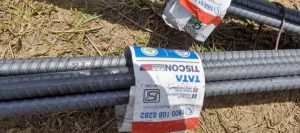
Use always Good Quality Bars Before the slab casting. Use Tata Tiscon 550 SD Grade for the Slab work, that is good for the India environment.
The main bars are placed on the shorter span of the slabs. But the distribution bars are placed in the longer span of the slabs. A higher diameter ( minimum 12 mm or 10 mm) rod is used as the main bars.
The lower diameter (8 mm) rod is used as a distribution bar. If the roof is a two-way slab, then use a 10 mm bar in the main bar as well as in the distribution bar.
Don’t make mistakes while laying bars. Use 16 mm rebar in beam and 8 mm 10 mm rebar in roof net.
To Know The Full Details About BEST STEEL Company In India- CLICK HERE To Read- Best TMT bar in India | TATA, SAIL, Jindal, JSW- With FE 500 D and More Grades
b). Main Bars
The size of the Bars should be 12 mm or 10 mm. It should be laying in such a manner that it looks like grid pattern (Square net) with 200 to 300 mm space in between bars.
c). Distribution bars
Size of Bars at least 8mm and the same pattern as the main bars.
d). Bent-Up Bar or Crank Bar Length
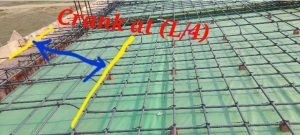
Where to provide cracked bars in slabs? How much distance should be there from the Beams? These are the common questions that may doubt you sometimes. Today you’ll clear all these in the next few lines.
There should be proper crank bar length while laying the rods on the roof. The crank bar gives roof strength. provide crank from all 4 sides in the two-way slab. Because in the supports like walls or columns, negative bending moments exist. So the cranks will resist the loads on the support. It resists buckling and is safe from the cracks develop in the slab.
That’s why this kind of mesh is formed with the Crank bars. Provide Crank length in the L/4 distance from the support in the rods. And the angle at which the crank is made should be a 45-60 degree angle.
6. Column Lapping Inspection
Generally, we see that some Bars don’t reach the Slab level. So that another same-diameter road is lapped with the previous one. Now it’s the centering laborers’ responsibility to give proper lapping to the column. More than 75 mm or 2.9 inch lapping is good.
7. Polythene sheet for Slab Casting
These Polythene sheets are available in the market at different Prices. It’s preferred that Nylon polythene is better than other plastics. It cost a Whole Bundle (9.200 Kg) Rupees 1240 and depends on the local or city market. If you’ll buy it in Kg, That will cost you 140 Rupees Per Kg. Other kinds of plastic are also available in the Market at the Price of 85 Rupees Per Kg.
These plastics are used below the Rods and over the Centering sheets to provide a smooth surface for the roof.
Oiling over the plywood – Oil is put in it over the plastic surface. Sometimes if it gets mixed in the rebar, it causes bonding and strength problems. So, don’t use too much oil.
8. Multipurpose Cover Block
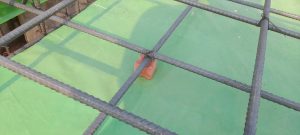
To Provide the Gape of 2 inch which is good for from the plastic sheet. cover blocks are used to give spacing above the shuttering work so that the bars are equally up from all sides. Keep a 20-25 mm gap between the shuttering surface and the steel rods.
It is preferred to put a roof and beam together while planning for the roof casting. The Beams are known as wall beams.
9. Safety Measures/ Personal Protective Equipment (PPE)
For the safety of working laborers bind a rope around the periphery of the Roof and The First ADD Kit must Be ready in case of any labor Injury.
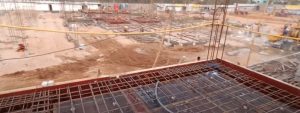
10. Concrete Pump
These are like pipes that transport the freshly made concrete from the batching Plant (Where concrete is made) to the Roof destination.
A common mix – 1:2:3 is (cement: sand: aggregate)
For strong mix- 1: 1.5 : 3 (cement: sand: aggregate)
The minimum ratio should be for RCC works is 1:1.5:3 that is cement, sand, and coarse aggregate as per IS standard. This ratio is sufficient to build up to four floors of residential buildings.
To get the exact amount of Ratio- 1 bag of cement means 1.23cu ft cement, multiply this figure by 1.5 and 3, to arrive at sand and aggregate quantity.
11. Proper Compaction
Provide Concrete Vibrator to have proper compaction of the concrete and evenly compact in all beams, columns, and through the slab. Compaction helps in removing the Air Voids and will give the concrete full strength for the Long period.
12. Slab Casting Temperature
The maximum and Minimum temperature should be in the site is 7-8 degrees and the maximum 30 degrees at the time of Slab casting.
13. Rain Water Pipe
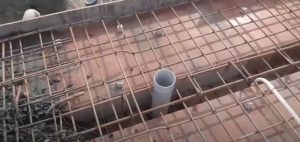
These 3 things should be known before giving rainwater pipes on the roof of the house. The roof level should be better to give the direction of the rainwater.
- PVC Plumbing Pipes are used in the roof slab before casting. Many times plumbers don’t know these useful things. so, it’s your responsibility to tell them before casting the roof slab. The size would be a 4” Pipe that is good to take the pressure of rainwater.
- Per Pipe Capacity- If you have a 400 Square foot floor, then one pipe will be sufficient to take the capacity of the Rainwater.
- Maintain the Distance between the two pipes and that Distance would be 18-20 Ft. should not be more than 20 feet. It is better to install the rainwater pipe with concrete and later while plastering, place it with the murga jali, it will fix the pipes in one place.
14. The electrical fitting before Casting
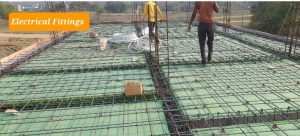
It’s done before Casting or a day before casting. After laying all the bars, the Electricians made plans to lay out the wires and installed all the necessary wires for fans, Lights, and other equipment. They charge 15-20 Rupees per square foot of the roof Slab.
You can prefer Outside open wiring fitting as well as underground fittings. But the underground fittings are good aesthetically. If your budget is less, you should prefer open wiring fitting.
15. Roof Slab beam shuttering removal time
Roof slab shuttering has been removed after 14-15 days According to the Indian IS 456: 2000 design code. After that, Remove all the Polythene from the Below surface area.
16. Curing after Removal of Shuttering
After the Removal of Shuttering, proper curing is necessary for the heat of hydration.
At the time of curing, you can put a sack on the surface or use the small mud wall to store water in the square section.
Also, Read-
Calculation of Bricks- Easiest way When Unloading
This Blog you’ll give you the important RCC Slab Casting Checklist for your next building plan. Don’t hesitate to comment if you’ve some idea or anything want to ask me. have a good day!





I’m extremely impressed together with your writing skills as well as with the structure to your weblog. Is that this a paid theme or did you customize it yourself? Either way keep up the excellent high quality writing, it is uncommon to see a great weblog like this one today!